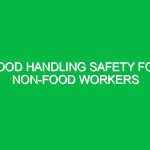Safety in the food industry is a critical aspect of the Health, Safety, and Environment (HSE) domain that affects not only the workers involved but also the consumers who rely on safe and nutritious food. The food industry encompasses a vast range of processes, from farming and harvesting to processing, packaging, and distribution. With such a diverse array of activities, the potential for hazards and risks is significant. Understanding these risks and implementing effective safety measures is essential to maintaining public health and ensuring the well-being of employees in the sector.
Understanding Safety in the Food Industry
At its core, safety in the food industry refers to the practices, regulations, and standards designed to prevent foodborne illnesses, accidents, and environmental hazards. This concept is vital within the context of HSE, as it addresses the intersection of human health, workplace safety, and environmental impacts. The repercussions of failing to adhere to safety standards can be severe, leading to outbreaks of foodborne diseases, workplace injuries, and even significant legal liabilities for food businesses.
For instance, consider the case of a well-known food processing plant in the Midwest, which experienced a significant listeria outbreak due to inadequate sanitation practices. This incident not only resulted in serious health consequences for consumers but also led to a costly recall and damage to the company’s reputation. Such examples underline the critical importance of safety protocols in the food industry.
Potential Hazards and Risks in the Food Industry
The food industry is rife with potential hazards, which can be broadly categorized into biological, chemical, physical, and ergonomic risks.
Biological Hazards
Biological hazards are perhaps the most well-known risks in the food industry. They primarily involve pathogens such as bacteria, viruses, and parasites that can contaminate food products. Common culprits include:
- Salmonella: Often found in raw poultry, eggs, and unpasteurized milk, salmonella can cause severe gastrointestinal illness.
- E. coli: Typically associated with undercooked beef and contaminated produce, E. coli can lead to serious complications, particularly in young children and the elderly.
- Listeria: This bacterium can thrive in refrigerated conditions, making it particularly dangerous in deli meats and soft cheeses.
Preventing biological hazards requires stringent hygiene practices, including proper cooking temperatures, regular cleaning protocols, and thorough employee training on food safety.
Chemical Hazards
Chemical hazards in the food industry can arise from various sources, including pesticide residues, food additives, and cleaning agents. For example, improper use of cleaning chemicals can lead to contamination of food products, posing significant health risks to consumers.
To mitigate these risks, it’s essential for food businesses to implement comprehensive chemical management programs. This includes proper labeling of chemicals, training employees in safe handling practices, and ensuring that all substances used in food processing comply with regulatory standards.
Physical Hazards
Physical hazards refer to foreign objects that can inadvertently end up in food products, such as metal shards, glass fragments, or plastic pieces. These hazards can arise from equipment malfunctions or human error. An example is a case where a broken piece of machinery led to metal fragments in a batch of canned goods, resulting in a nationwide recall and consumer panic.
To prevent physical hazards, food manufacturers should conduct regular equipment maintenance, establish thorough inspection protocols, and promote a culture of safety among workers. Implementing metal detection systems can also significantly reduce the risk of physical contamination.
Ergonomic Risks
Ergonomic risks in the food industry often stem from repetitive motions, awkward postures, and heavy lifting. Workers in food processing plants frequently face physical strain that can lead to musculoskeletal injuries. For instance, a worker lifting heavy bags of flour daily may develop chronic back pain over time.
To combat ergonomic risks, businesses should assess workstations for ergonomic safety, provide proper lifting training, and encourage regular breaks to minimize physical strain.
Best Practices and Safety Precautions
Implementing effective safety precautions is vital for protecting workers and consumers alike. Here are some actionable best practices:
1. Employee Training and Awareness
One of the most effective strategies to ensure safety in the food industry is comprehensive employee training. Workers should be educated on food safety principles, proper hygiene practices, and the potential hazards they may encounter in their roles. Regular refresher courses can help maintain awareness and adherence to safety protocols. For example, a training session on cross-contamination can significantly reduce the risk of foodborne illnesses in a kitchen.
2. Hygiene and Sanitation Practices
Maintaining high hygiene standards is essential for preventing biological hazards. This includes regular cleaning of equipment, surfaces, and hands. Businesses should establish a clear sanitation schedule and ensure that all employees understand the importance of maintaining cleanliness in food handling areas.
3. Regular Inspections and Audits
Conducting frequent safety inspections and audits can help identify potential hazards before they become significant issues. These inspections should cover equipment functionality, cleanliness, and adherence to safety protocols. Regular audits not only enhance safety but also foster a culture of accountability among employees.
4. Compliance with Regulations
Adhering to local and international regulations is crucial for ensuring safety in the food industry. Organizations such as the Food and Drug Administration (FDA) in the United States and the European Food Safety Authority (EFSA) provide guidelines that must be followed. Compliance not only protects consumers but also shields businesses from legal repercussions.
5. Emergency Preparedness
Having an emergency response plan in place is vital for addressing potential crises, such as food contamination incidents or workplace accidents. This plan should outline procedures for reporting incidents, managing recalls, and communicating with relevant authorities. Regular drills can help ensure that all employees are familiar with the emergency procedures.
Regulations and Standards Governing Safety in the Food Industry
Numerous regulations and standards govern safety in the food industry, aimed at protecting public health and ensuring safe food production practices. Some of the most notable include:
- HACCP (Hazard Analysis Critical Control Point): This systematic approach identifies and controls hazards throughout the food production process.
- FSMA (Food Safety Modernization Act): Enacted in the United States, this legislation aims to ensure the U.S. food supply is safe by focusing on prevention rather than response.
- ISO 22000: An international standard that outlines the requirements for a food safety management system.
Compliance with these regulations is not merely a legal obligation but a critical component of maintaining consumer trust and ensuring food safety.
Conclusion
Safety in the food industry is a multifaceted challenge that requires constant vigilance, effective training, and adherence to regulations. By understanding the potential hazards and implementing best practices, food businesses can create a safer environment for their employees and consumers. As the industry continues to evolve, prioritizing safety will remain paramount in safeguarding public health and maintaining the integrity of the food supply chain.


